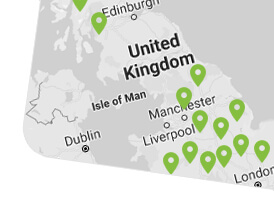Are you sure you want to perform this action?
Planning Permission

Before constructing a new garden building, it is essential to determine whether the structure needs a Planning Permission or is exempt from this requirement. Some buildings featuring specific technical characteristics could not require Planning Permission, allowing you to avoid the hassle of the application process, thus saving time and money. However, there is a high chance that your selected building will not meet all the requirements regarding its type, size, location, purpose, and technical specifications to be Planning Permission free. What is more, the regulations differ significantly depending on the location, which makes the entire process even more complicated.
If you would like our assistance in this process by providing you with the drawings, accompanying documents, or any other necessary guidance, we can offer it to you as an additional service.
Planning Permission Support Process
For your convenience, we can offer comprehensive support to help you obtain Planning Permission for your project. Our process is designed to be straightforward, efficient, and tailored to your specific needs.
Before proceeding with the assisted planning permission obtaining process, please thoroughly read the 12th paragraph of the Terms and Conditions page.
Step 1: Initial Site Review & Consultation
• Fee: £500 (includes drawings prepared by us)
• Timeframe: Completed within 5 working days
During this stage, we will:
• Review the initial information and guidelines provided by you.
• Evaluate your individual case, comparing it with our current data and know-how, taking into consideration similar situations in the region, and decide the following steps of the process.
• Provide an executive summary with an assessment of the planning status and recommendations for proceeding.
Our Recommendations May Include:
• Lawful Development Certificate (LDC): If the project falls within permitted development rights.*
• Full Planning Application: If formal Planning Permission is required.
• Outline Planning Application / Pre-Application Advice: For complex or sensitive sites (e.g., conservation areas, listed buildings).
• Conclusions that the project is not viable: If the project is unlikely to receive approval.
Step 2: Planning Application Options
Based on the initial review, we will guide you through one of the following routes:
Option 1: Lawful Development Certificate (LDC)
• Fee: £900*
*Depending on your location, an additional local planning authority fee may apply (typically ranging from £400 to £900).
• Timeframe: 8–10 weeks
As an outcome, we will:
• Prepare a full set of drawings.
• Complete and submit the application forms to your local council on your behalf.
• Manage the entire process, liaising with the council as needed.
Option 2: Full Planning Application
• Fee: £900*
*Depending on your location, an additional local planning authority fee may apply (typically ranging from £400 to £900).
• Timeframe: 8–10 weeks
We will:
• Prepare a comprehensive drawing package.
• Complete and submit all required application forms on your behalf.
• Manage the process with your local council to ensure smooth progression.
Option 3: Special Projects (Complex/Sensitive Sites)
For projects with unique challenges, such as those in conservation areas or involving listed buildings:
• Fee: Determined based on the specific project requirements.
• Scope: Tailored to the complexity of the project, potentially including additional reports, specialist consultations, and extended management.
* Permitted Development
You can perform certain types of work without planning permission, including - in certain circumstances - adding a free-standing garden building to your property. These are called 'permitted development rights'. Permitted development criteria are complex and may be affected (or even removed entirely) by a number of factors, including, for example, type of property, existing buildings / previous developments, land coverage, neighbouring properties/boundaries, properties located in 'designated areas', etc. We always recommend seeking professional advice and checking with your local planning authority. You can also find more information on the Government website: Planning Portal
Lawful Development Certificate
If you want to be certain that your planned building project does not require planning permission, you can apply for a 'Lawful Development Certificate' (LDC). It is not compulsory to have an LDC but there may be times when you need one to confirm that the completed project is lawful from a planning control perspective. For example, if you sell your property, LDC may be needed to evidence that changes or additions you have made to the property are lawful.
Get in Touch
If you're ready to start your project or need more information, contact us today. We'll guide you every step of the way, from the initial site review to securing your Planning Permission.
Planning permission free constructions
If your selected building meets all the requirements presented below, you will not need to apply for Planning Permission.
Planning permission is NOT required if:
• You are building a single-storey outbuilding in your premises (e.g., your backyard).
• Your selected building does not feature a balcony, platform (raised more than 300 mm from the ground) or veranda. We have ensured that our wooden structures featuring veranda are not raised more than 300 mm from the ground.
• The roof of the building is up to 4 m in height (double-pitched) or up to 3 m in height (single-pitched). The eaves must be up to 2.5 m in height.
• The ridge height is up to 2.5 m (if the house is built within 2 m of the boundary) or 4 m (if the house is built more than 2 m from any boundary).
• The newly built structure will be used for non-residential purposes only (e.g., lounging, storage, or remote working).
If you answered “yes” to all the statements above, you will likely not require Planning Permission for your building. However, in each individual case, we recommend double-checking with your Local Planning Authorities. For your convenience, we have uploaded a sample application letter for your local planning authorities (download here). Please refer to the planning rules related to the location of the building here.
Planning Permission free mobile homes
If you want to build a more spacious structure that could be used for residential purposes for you or your family members, our mobile homes provide the exclusive benefit of building Planning Permission free.
Keep in mind that both of these conditions must apply for such structures:
• The building has to meet the legal definition of a mobile home (all our Planning Permission free mobile homes meet this criterion).
• The mobile home must be dedicated to personal use (or family member) only and not be used for sale or rental purposes.
For your convenience, we have curated a vast assortment of mobile homes which do not require Planning Permission, allowing you to build an additional structure in your garden for personal use, with less documentation hassle and costs involved.
If you would like to clarify certain aspects regarding your selected wooden building, we will be glad to answer your questions - do not hesitate to call us 02070994301 or write us [email protected]












